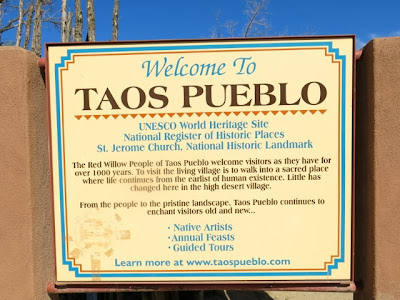Taos Pueblo is considered to be the oldest continuously inhabited community in the USA -- more than 1000 years. Taos is the northernmost of the nineteen New Mexico Pueblos.
The native language of the Red Willow People - Tiwa - is unwritten and unrecorded, and will remain so. They consider their traditional values as sacred and will not divulge their detailed oral history for reasons of religious privacy.
The buildings are made entirely of adobe. Adobe is earth, straw and water mixed and poured into forms. After the bricks are sun-dried, they are stacked and bonded together with the same adobe mixture. The walls are frequently several feet thick and the interiors are coated with washes of white earth to keep the rooms bright and clean. The roofs are supported by large timbers/vigas.
HORNO is the Spanish word to describe the outdoor adobe oven that is used mostly to bake bread and pastries by the women of the Pueblo.
The two main structures of the Pueblo are called Hlaauma / North House and Hlaakkwima / South House. These structures are believed to be well over 1000 years old. The buildings are actually many individual homes built side by side and in layers with common walls and no connecting doorways. The Pueblo looks much like it did when the conquistadors first arrived. The exception is the introduction of doorways. At one time, the only entryway into the homes was by ladder through an opening in the rooftops.
These men are mudding the outside adobe. They told John that they have to do this once a year.
These are the dogs of Taos Pueblo ... walking and sleeping freely wherever they want. They all look to be well fed. This is the only place, other than the town of Assisi in Italy, where I have seen free dogs.
Here, they rest under one of the "drying racks", which are used for drying wild game for beef jerky. The Natives also dry their harvested corn, pumpkin, squash, and been crops. Wild berries and animal hides are also dried and cured on these racks.
The San Geronimo Church, built in 1850, is one of the youngest buildings in the village.
Today, about 3/4 of the population shares in some of the Catholic practices, while the native rituals perseveres 100% in daily life.
We're not sure what that bottom language is ...
The original San Geronimo Church was built around 1619 and its ruins are in the cemetery. It was built by Spanish priests with Indian labor. The Taos Pueblo were forced into Catholicism and slavery in order to become "civilized". This is what eventually led to the Pueblo revolt of 1680. Taos Pueblo was prominent as the headquarters for the revolt. The revolt was successful and the Pueblo people of New Mexico lived freely until the reconquest by the Spanish in the 1700s.





























Fascinating, a whole different culture is kept alive there. Are these actual homes or is it more an open air museum?
ReplyDeleteThat language was either Japanese or Chinese. Both use the same characters, although Japanese often uses its own characters in addition to the ones originating from Chinese. I will look these up, but I am sure they must mean the same thing as the expressions above it.
I re-read the first sign re Taos Pueblo and it is a living village. It just seemed rather deserted except for tourists. The adobe buildings look deserted to me.
DeleteMany of the lower level "homes" are actually little shops for selling crafts, jewelry, food. But it was obvious that several of the buildings were lived in. There were also several homes surrounding the pueblo village that were obviously Native homes and marked with "private" signs. I know that Natives are very conscious of having their picture taken so I deliberately do not photograph them, even when they are demonstrating something or just sitting around.
DeleteTHat makes sense about the characters being Japanese or Chinese since so many of the tourists at these places are Asian. At first I thought it looked like a written form of Native language that I saw at a museum in Pittsburgh.
DeleteIt is the equivalent of saying "Keep Out". It is pronounced: ta-chi-ri-i-kin-shi in Japanese. It literally translates as stay (stand) entering prohibition. The characters would be understood by Chinese but not pronounced the same.
Deletethanks, Barbara ...
Delete